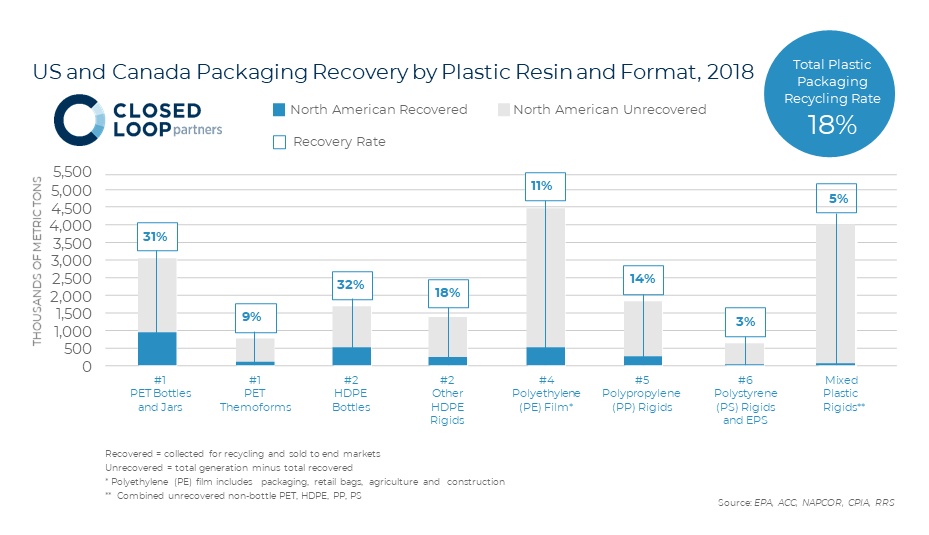Research and analysis
A Data Visualization Tool Identifying Opportunities to Recapture Plastic in the US & Canada
Demand for recycled content is growing rapidly, with more than 250 brands and retailers in the U.S. committing to increase their use of recycled content in products and packaging. While 90% of plastic waste ends up in a landfill, incinerator, or worse, in our oceans and the environment, the current supply of recycled plastics meets just 6% of demand for the most common plastics in the US and Canada because of technical or market barriers. This highlights the significant gap between where we are and where we need to be.
Using plastic packaging as a starting point, this tool guides investors, brands, entrepreneurs and policymakers to make data-driven decisions that drive toward a circular future. The map brings to light the diversity of plastic waste, breaking down the volumes of plastics by type and the flows by country, state and province. In doing so, it highlights the critical opportunities to recapture valuable plastics and re-incorporate them into manufacturing supply chains. Enhancing the transparency of supply chains and better understanding the current flow of materials are essential first steps to improve plastics recovery.
And as we collectively move forward on our journey toward circularity, we need to go beyond packaging and capture the full range of plastics flowing through supply chains, including plastic-based healthcare products or textiles, among others. We call upon industries to join us, and share critical data on their plastic waste streams to shed light on opportunities to keep all kinds of plastics in play.
US and Canada Recycling Infrastructure and Plastic Waste Map
Interactive Data Map
Data only available in desktop view.
How It Works
Jon Powell, Vice President at Closed Loop Partners, walks us through the US and Canada Recycling Infrastructure and Plastic Waste Map, joined by Resa Dimino of RRS and Trina Matta of The Recycling Partnership. Together, they dig into why we developed this tool, how to use it and what’s needed to drive towards a circular future for plastics in the U.S. and Canada.
What We Discovered

Key Findings
11.5 million metric tons of plastic packaging are sent to landfills in the US and Canada every year and only 18% of this is currently recaptured by the recycling system.
Formats, applications and end-of-life markets for the different plastic resins are varied within the packaging sector alone, many requiring different recovery pathways, depending on the regional nuances of the existing recovery infrastructure and end-markets available for recycled materials.
A range of strategies, each with different strengths and limitations are necessary to capture all kinds of plastics, including mechanical and advanced recycling; reusable packaging systems also need to be implemented to reduce overall volumes of plastic production.
The full spectrum of plastics in the waste stream goes well beyond packaging; hard-to-recycle plastics like car parts, healthcare plastics and textiles need to be considered to capture all plastic waste. This tool reveals a gap in the plastics accounted for today.
A more robust understanding of the status quo of plastic flows in the U.S. and Canada will help set the stage for increased processing of used materials across the country, which deliver feedstock for both mechanical and advanced recycling, in doing so generating additional jobs and mitigating greenhouse gas emissions.
What’s Next?
By shedding light on today’s plastic waste, the tool reveals opportunities for collaboration and investment to increase the recovery of plastics to build a circular economy. These insights help drive policies for waste collection, show incentives to improve recycling and recovery infrastructure and services and reveal gaps for advanced and mechanical recycling technologies to fill.
Call To Action
We call upon industry to look beyond packaging and collect data on all plastic waste to create a circular future. We need to work together to build a more robust data set. We invite leading industries, including textiles, electronics and healthcare plastics, to join us and share their insights and data to help paint a more accurate picture of today’s plastic waste so that we can identify opportunities to capture plastics before they become waste.
Acknowledgements
Our Center for the Circular Economy partnered with Target Corporation, Bank of America, Colgate-Palmolive, 3M, The American Chemistry Council and Sealed Air to produce the U.S. and Canada Recycling Infrastructure and Plastic Waste Map. Our technical partners on this project included Resource Recycling Systems and The Recycling Partnership. Resource Recycling Systems (RRS) produced the Closed Loop Partners Plastic Waste Map.
Data Sources & References
- American Chemistry Council (ACC) – Resin Review, 2020 Edition
- American Chemistry Council (ACC)/Association of Plastic Recyclers (APR) – 2018 National Post-Consumer Plastics Bottle Recycling Report (MORE Recycling, 2020)
- American Chemistry Council (ACC)/Association of Plastic Recyclers (APR) – 2018 National Post-Consumer Non-Bottle Rigid Plastic Recycling Report (MORE Recycling, 2020)
- American Chemistry Council (ACC)/Association of Plastic Recyclers (APR) – 2018 National Post-Consumer Plastic Bag & Film Recycling Report (MORE Recycling, 2020)
- Canadian Plastics Industry Association (CPIA) – 2017 Post Consumer Plastics Recycling In Canada (MORE Recycling 2019)
- Governmental Advisory Associates (GAA), Materials Recycling and Processing Yearbook, 2020
- IHS Markit – Polymer Data 2018
- Ministry of Environment and Climate Change (Canada) – Economic Study of the Canadian Plastics Industry, Markets and Waste (Deloitte and Cheminfo Services Inc. 2019)
- S. Environmental Protection Agency (EPA) – Advancing Sustainable Materials Management: 2016 and 2017 Tables and Figures (EPA 2019)
- The Recycling Partnership (TRP) – 2020 State of Curbside Recycling Report (TRP, 2020)
- Container Recycling Institute (CRI) – Bottle Bills – Benefits & Challenges (Susan Collins, CRI, 2019)
- Canadian Council of Ministers of Environment – State of Waste Management in Canada (Giroux Environmental Consulting, 2014)
- Resource Recycling Systems (RRS) – MRF Material Flow Study (RRS, Reclay StewardEdge, MORE Recycling, 2015)
- Resource Recycling Systems (RRS) – Proprietary Reports and Data (RRS, 2020)

